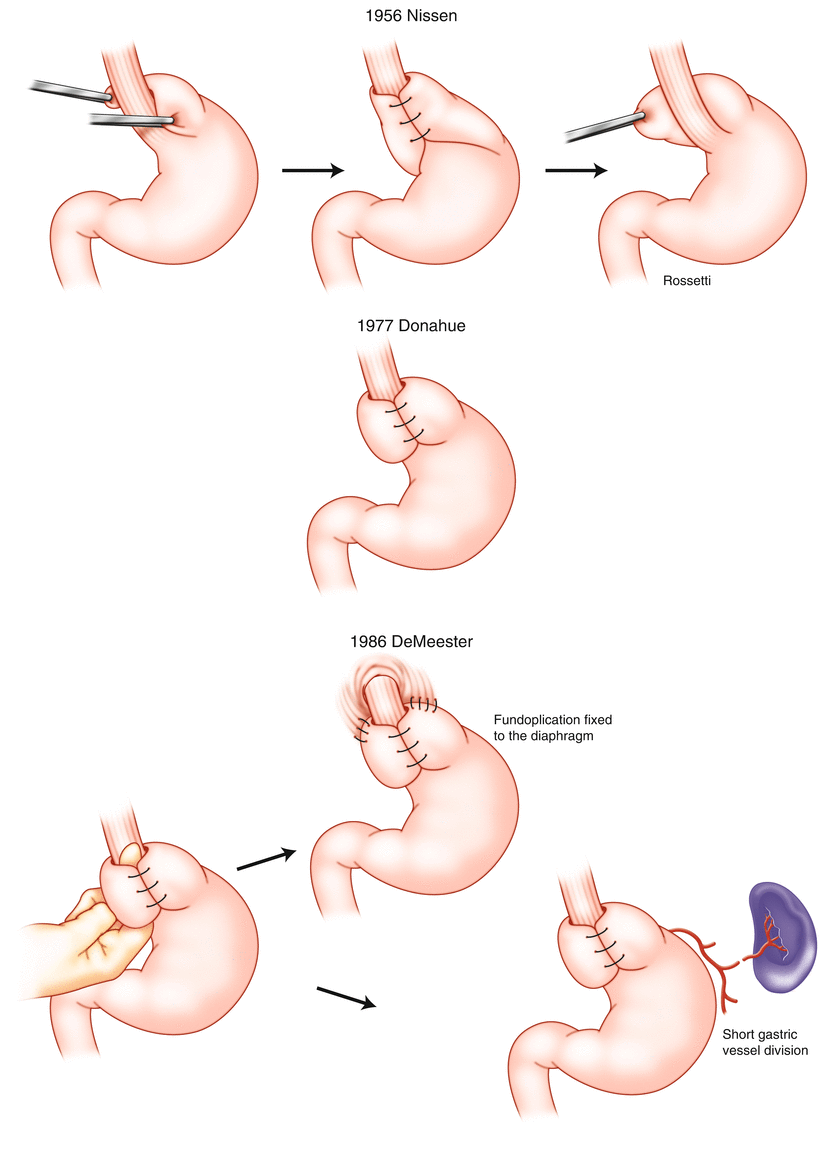Fig. 1.1
Rudolph Nissen (Source: National Library of Medicine)

Fig. 1.2
Nissen fundoplication evolution from the original description in 1956 of a long and tight wrap to the final short-floppy valve. Minor modifications, such as the use of the anterior wall of the stomach and division of the short gastric vessels, are shown on the right-hand side
1.1.2 Achalasia
Ernst Heller (Fig. 1.3) devised a very successful technique for the surgical treatment of achalasia, which is used to treat most patients with this disease, similar to Nissen’s contribution to the treatment of GERD. Heller was born in 1877 in Eichenwalde, Germany, and died in Leipzig in 1964. He described the famous myotomy in 1913, just before serving in the First World War.
Surgical treatment for achalasia started with cardioplasties of the esophagogastric junction. Heller’s “extramucosal cardioplasty” (Fig. 1.4), an idea based on pyloromyotomy, was first proposed by Gottstein in 1901 but he never performed it. It consisted of an anterior and posterior vertical extramucosal esophagomyotomy of 8 cm, from the dilated segment of the esophagus to a small extension into the stomach, performed through a subcostal incision. Additionally, omentum was fixed to the anterior myotomy to prevent its approximation. A single myotomy, as described by Groeneveldt in 1918, became more usual, and a fundoplication was added later. The first minimally invasive myotomy was carried out by Shimi et al. in 1991.



Fig. 1.3
Ernst Carl Paul Heller (From Weiner RA. Ernst Heller und die myotomie. Chirurg. 2014;85:1016–22; with permission from Springer Science + Business Media)

Fig. 1.4
Franz Torek (Source: National Library of Medicine)
1.2 Malignant Diseases
1.2.1 Esophageal Cancer
It is frequently said that the development of transhiatal esophagectomy preceded the transthoracic approach as a way of avoiding the open chest prior to mechanical ventilation, but in reality, 1913 marked the beginning of both procedures.
In the same year, Alwin von Ach (1875–1924), a German surgeon, described the first esophagectomy without thoracotomy in his doctoral thesis. Not is much known about him. The esophagus was resected by stripping through the neck after the divided proximal stomach was connected to a steel rod (Fig. 1.5a). The alimentary tract was not reconstructed, and the patient died on the 17th day.
Franz John A. Torek (1861–1938), a German surgeon working in the United States, performed the first successful transthoracic esophagectomy in that year. The alimentary tract was not reconstructed, but the patient was fed with an external rubber tube connecting the cervical esophagostomy and the gastrostomy (Fig. 1.5, top in b). This patient had a long survival.
Stay updated, free articles. Join our Telegram channel

Full access? Get Clinical Tree








